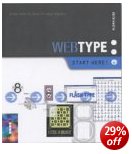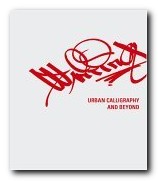from typographic zero to hero in easy lessons
This is a very stylish production giving an overview of Web type. Every double-page spread has been carefully planned and laid out. It’s a book which follows the same principles of good design it espouses. Tom Arah starts with a crash course in the history and principles of typography, then quickly accelerates into the computer age, covering screen-readable fonts, and typeface conventions. Each page is as deeply layered as its possible to be in two dimensions, and every topic is illustrated with several graphic examples and screenshots. It’s a delightful book to browse as well as to read in depth. It’s a great introduction to the subject.
 There’s a very user-friendly introduction to HTML, with a quick-start tutorial on how to control layout, colour, space, and fonts. All this is designed to create more visually interesting Web pages. Next comes the introduction of graphic images, displaying fonts correctly, and making them look as attractive and efficient as possible. It’s all done via a series of thirty-three practical projects. These take you through the skills required to control type and layout on screen
There’s a very user-friendly introduction to HTML, with a quick-start tutorial on how to control layout, colour, space, and fonts. All this is designed to create more visually interesting Web pages. Next comes the introduction of graphic images, displaying fonts correctly, and making them look as attractive and efficient as possible. It’s all done via a series of thirty-three practical projects. These take you through the skills required to control type and layout on screen
He shows you how to use style sheets, and there’s even advanced stuff on the type-handling abilities of Macromedia Flash and Adobe Acrobat. There’s a beginner’s introduction to Flash which I found useful as someone who wants to know the basic principles. He even shows you how to do Flash tricks using free software – so you don’t have to buy expensive programs.
If you are frustrated by the limitation of font control in HTML – and who isn’t! – you’ll be glad to read his explanation of font embedding – which rightly describes as “the Web’s best-kept secret”.
This is followed by a careful tutorial on using cascading style sheets, which he takes one step at a time, explaining not only type control but page layout and the control of all design elements. Web browsers are still catching up with these possibilities – but he takes a look ahead to CSS 3, which with luck will create a common set of standards.
I looked at a couple of other manuals whilst reading this, and was amazed at how old-fashioned they suddenly appeared. Books like this are setting new standards for presentation and production values.
© Roy Johnson 2004
Tom Arah, Web Type: Start Here!, Lewes: ILEX, 2004, pp.192, ISBN: 1904705189
More on typography
More on technology
More on digital media
